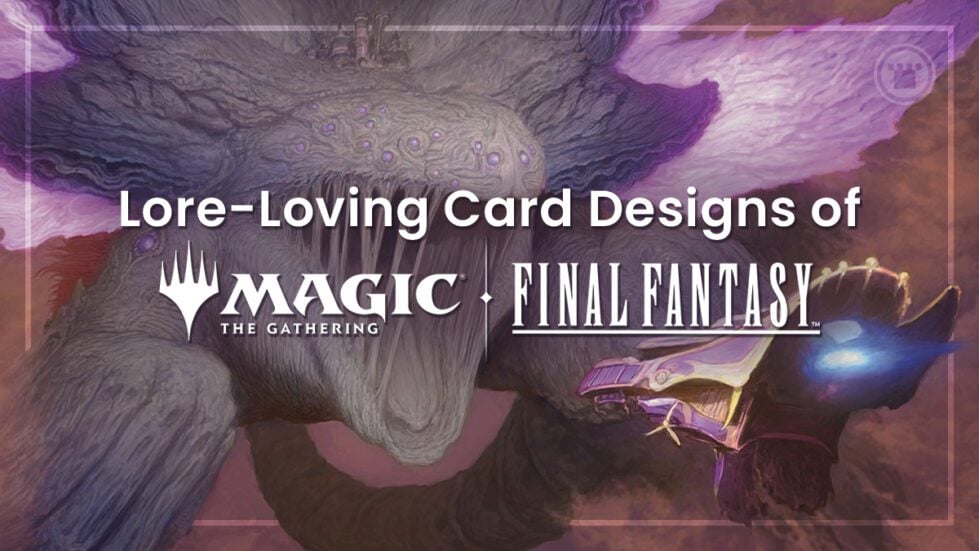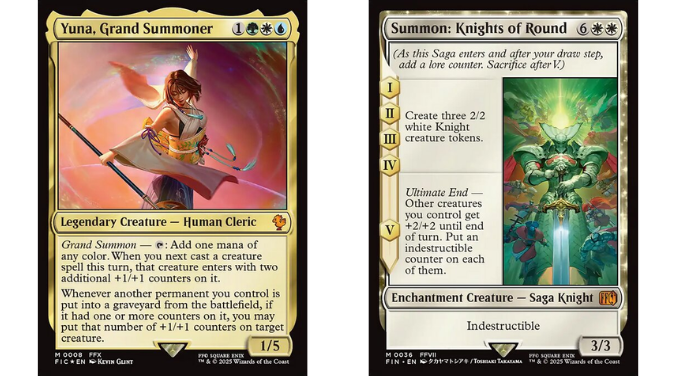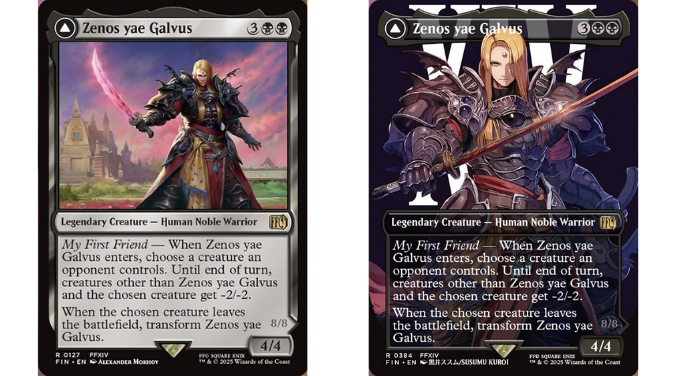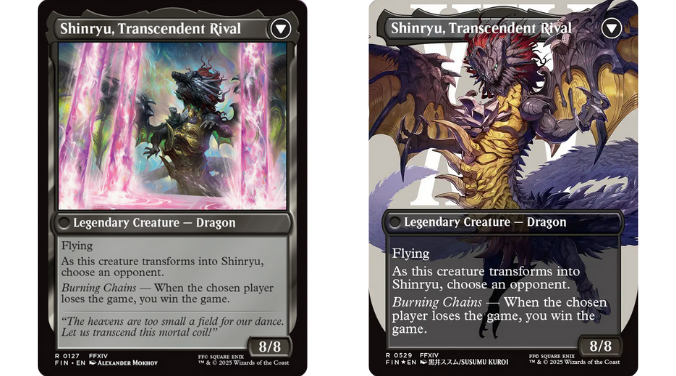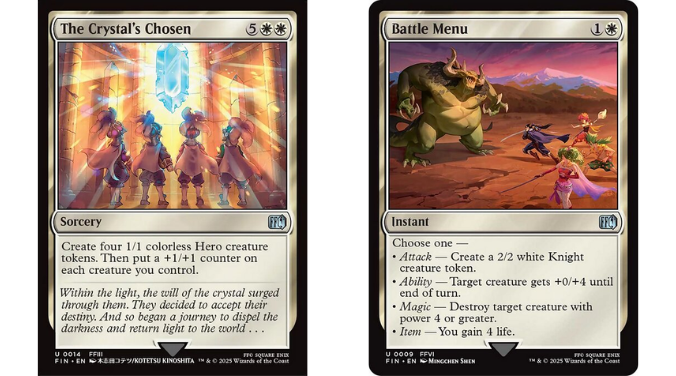The spoiler season for Final Fantasy has been an absolute tour de force, setting a new high bar for hype around Universes Beyond. To me, it’s another reminder how cool it is to see familiar references from another franchise transmuted into Magic mechanics; it’s like game design alchemy.
In the past, this kind of “top-down” design has featured in sets linked to rich mythological canons – classical Greek and Norse culture, or the extensive worldbuilding of J.R.R. Tolkien. But with every game in the series offering up its own iconic moments and characters, Final Fantasy offers arguably an even deeper pool of inspiration.
Just by reading these new cards you can tell how much fun Wizards had coming up with them, and how hard they worked to tie their mechanics back to the original source so that they’d feel right to the fans. Here’s a shortlist of the cards which most impressed me with their cleverly lore-accurate effects!
NOT-SO-RANDOM ENCOUNTERS
In a series that’s always changing setting and characters, it ends up being the recurring monsters and items that make it “feel like Final Fantasy”. Some of these monster designs have appeared over and over again with similar looks and abilities, becoming fan-favorites in their own right.
So it is for the horrifically tentacled Malboro and cutely terrifying Tonberry, both of whom have now made the leap into Magic as well!
Both are black creature cards with the “Horror” creature type, used in for monsters which are nightmarish and weird but not demonic; a great fit. The abilities on each card are named after their most iconic Final Fantasy special attacks. In the games, a Malboro’s Bad Breath doesn’t do much damage but inflicts a crippling mixture of debuff effects – represented on the new card by diminishing three different resources for your opponents.
Tonberry’s card design is simple but brilliant. Its Chef’s Knife attack is slow, but famously lethal, shambling forward to instantly K.O. any hero of light. The Magic designers realised the simple combination of first strike and deathtouch would allow Tonberry to slay a blocker of any size, while stunning it for a turn on ETB creates the right sense of “creeping doom”!
An even more consistent series staple is the Phoenix Down. This all-important consumable item appears in every single Final Fantasy game, almost always with very similar effects: it brings a fallen hero back to life, giving the party a chance to bounce back from boss attacks or fatal mistakes. The Magic design, of course, represents this as a relatively cheap artifact that can be used (once) to reanimate a creature from the graveyard!
That would probably have been enough on its own, but I really like that the card also recognizes the… less orthodox usage of Phoenix Down. In many games, using this kind of resurrection magic on undead opponents will instantly slay them! So of course the Magic version can also be used to exile a Skeleton, Spirit, or Zombie type creature. I suppose Vampires in Final Fantasy are more likely to be boss-level monsters and thus immune to this kind of cheesy strategem.
LEADING LADIES
Hopping over to the Commander side of Final Fantasy, I want to shout out the design of Yuna, Grand Summoner. The decision to represent all summons/eikons/eidolons from the games as saga creatures is innovative from a Magic perspective, but I can’t really call it a “lore win”.
But by choosing to make these summons such a unique kind of card, the designers created the opportunity for equally unique “support cards” which are clearly and powerfully linked to those summons. What better way to capture the identity of a Grand Summoner like Yuna?
Her card here synergizes with the aforementioned saga creatures on multiple levels. First, her active ability helps you access summons which would be too expensive or in the wrong colors otherwise – they all answer to her call.
To cement Yuna’s unique talent, anything she helps cast is also more powerful than it normally would be. This applies even to “normal” creatures (which gives her more flexibility in deckbuilding) but pays off extra-hard for summons because of her other ability.
The fact the summons are saga creatures means they are going to have a bunch of “extra” chapter counters on them when they leave play, in addition to +1/+1 counters generated by Yuna or other sources. Her trigger counts these chapters along with everything else, converts them all to extra stats and transfers that huge power boost to the next creature. As each summon naturally expires it will only make the next in line mightier and mightier! It’s an awesome play pattern where Yuna can be the centerpiece without having to do the damage herself.
Another cool thing about this set is how it gives some love to even the less-celebrated Final Fantasy games and their characters. Quistis is the whip-smart combat school instructor who supports Squall from the very outset of Final Fantasy VIII. In the broad parlance of the series, Quistis is a “blue mage”, a caster who copies spells and attacks used by monsters and wields them herself – which fits, since in that game basically all spellcasting works like blue magic.
This makes her card an excellent choice to show off the ability the Magic designers chose to represent blue magic (also present on Blue Mage’s Cane from the Commander set). Any instant or sorcery that an opponent has cast, Quistis will be able to draw out of their graveyard and use against them! Technically she can also cast spells from your own graveyard, which is a bit less flavorful, but that’s just to make sure Quistis is always a valuable member of your party!
EORZEAN EXCELLENCE
Any of the cards in the “Sidequest” cycle could be worthy of a look here, but as someone who’s put in my hours on Final Fantasy XIV this one really made me smile.
The “Mark” system is one of many kinds of sidequest players can take on as a break from the long, winding story or multiplayer dungeons – you’re tasked with simply going out into the world and hunting down specific marked monsters.
This starts out as the most elementary MMO gameplay imaginable, but as your hero collects bounties and progresses to higher ranks, the marks you’re hunting become more unusual and outlandish. Eventually you’re taking bounties on espers, demigods, and other massive beasts, fighting alongside huge swarms of fellow players who are all there to share credit for the kill.
The concept of a sidequest is much more abstract than a hero or monster, but this card finds a wonderful angle to do so. It starts out with you defeating your first target, rewarding you with a treasure at end of turn. If you want more bounties you’ll have to find other ways to destroy opposing creatures… but if you manage, you can suddenly find yourself on the battlefield with Yiazmat, an Ultimate Mark. Perfect!
Speaking of Final Fantasy XIV, I couldn’t get out of this article without finding space to celebrate my favorite villain. Zenos is an amazing switch-up from the egotistical, megalomaniacal antagonists who are so inescapable across fantasy media and RPGs – especially the Final Fantasy series. Despite being born an imperial prince, blessed with preternatural strength and skill, Zenos is a weird loser with no real goals. Then he hears about the Warrior of Light, decides that they are the only opponent strong enough to be his peer, and proceeds to kill as many people as it takes to get their attention.
Seeing evil done by a shallow man with petty, childish goals is as galling as it is horrific, and Zenos is even more loathsome for how much he enjoys your confrontations. After all, you are his first friend…
His Magic card captures this dynamic hauntingly well: as soon as he enters the game, the prince chooses his rival and massacres all other weaklings around them – his own soldiers, and theirs. But should his “friend” not stick around to humor his sick request, Zenos will dramatically raise the stakes.
Just as he does in-game, he allows himself to be possessed by the primal Shinryu, finally threatening to destroy the whole world just so his rival can’t say “no” to a last winner-take-all duel. The fact that Magic Zenos literally changes a multiplayer Commander game into a perverse 1v1 is the epitome of flavorful top-down design and a high watermark for future Universes Beyond sets.
WHY CALL IT “FINAL” FANTASY WHEN IT KEEPS ON GOING…
I won’t pretend to be among the most diehard Final Fantasy fans, but I have certainly spent a lot of time with a few favorites from the series, and I respect the massive imprint these games have had on gaming culture.
This is also one of the few other long-running franchises one can compare to Magic in how they have built an identity not around recurring characters or worlds, but with elements like monsters, spells, NPCs, and artifacts which reappear over and over in slightly different forms. Magic players can feel at home on any plane where they see a mana-producing green elf, a blue spell that returns creatures to hand, or a white Oblivion Ring effect. The Final Fantasy games find that kinship in Ifrit, Ramuh and Shiva, in Ultima Weapons and airships piloted by a guy named Cid.
When your fans have so much emotional investment in these familiar gameplay elements, translating them over to a totally different type of game carries a lot of risk! But the team behind this set seem to have carried it off with aplomb, to the point that I can’t even call out all their wins in the one article (honorable mentions to Dancer’s Chakrams, and Esper Origins using the word “flashback”)!
I hope everyone involved plays themselves a classic victory fanfare over this one. It’s well earned.

Tom’s fate was sealed in 7th grade when his friend lent him a pile of commons to play Magic. He quickly picked up Boros and Orzhov decks in Ravnica block and has remained a staunch white magician ever since. A fan of all Constructed formats, he enjoys studying the history of the tournament meta. He specializes in midrange decks, especially Death & Taxes and Martyr Proc. One day, he swears he will win an MCQ with Evershrike. Ask him how at @AWanderingBard, or watch him stream Magic at twitch.tv/TheWanderingBard.

